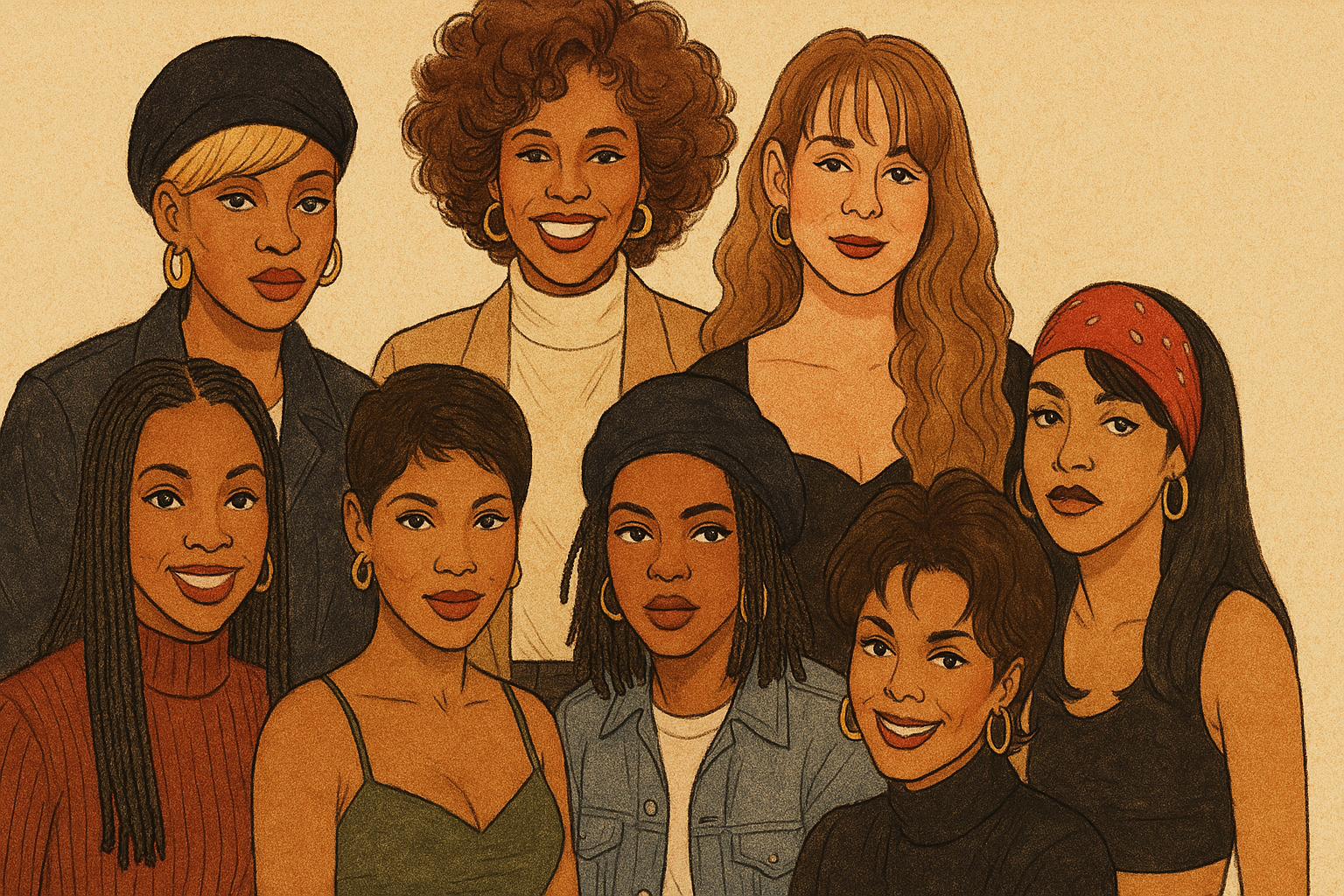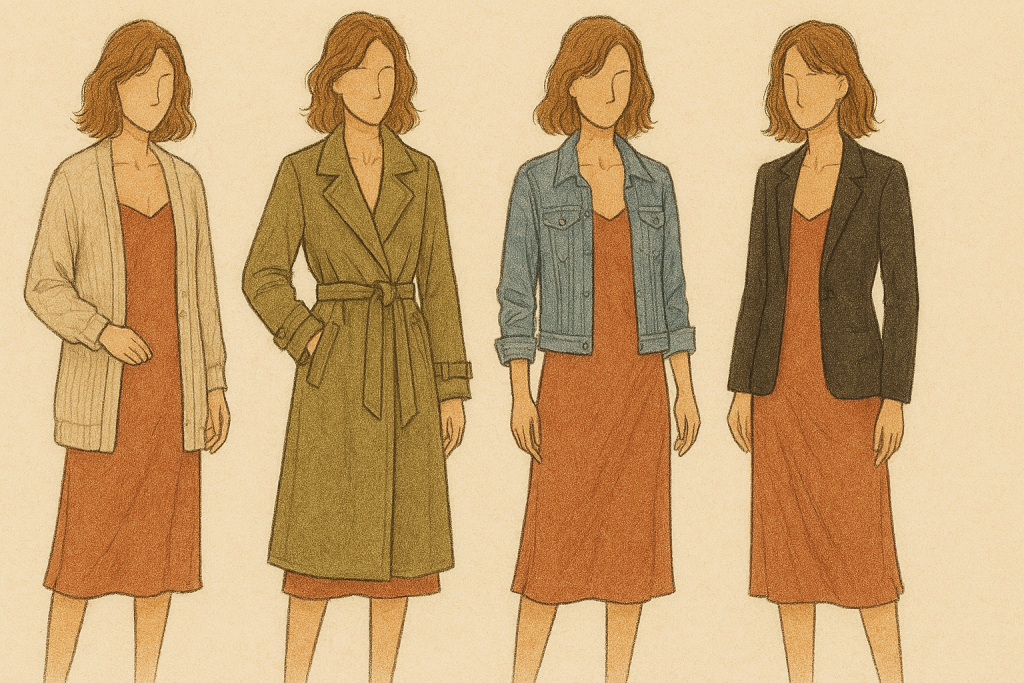“Music is the strongest form of magic.” – Marilyn Manson
There’s something undeniably magical about the sound of the 1990s. It was a decade of booming creativity, boundary-pushing artistry, and some of the greatest voices to ever grace the airwaves. For R&B music, it was a renaissance of soul, and at the heart of that resurgence were the female artists who shaped the genre, broke records, and redefined what it meant to be a powerful solo artist in the music industry. These women weren’t just singers—they were cultural forces. They wrote anthems that told stories of heartbreak and healing, sisterhood and self-discovery, freedom and fire. They dominated music charts, released some of the most celebrated #albums of all time, and helped create a lasting legacy that still influences the sound of today.
This is a tribute to the best 90s female R&B singers, whose talent, resilience, and iconic voices left a permanent mark on music history.
Mariah Carey – The Crossover Genius with a Five-Octave Voice
When Mariah Carey made her debut in 1990, the industry had never seen anything quite like her. Born to a multicultural family and raised in Long Island, Carey entered the scene with the kind of raw talent that could stop time. Her debut single, “Vision of Love,” didn’t just introduce a new voice—it introduced a new standard for vocal talent in pop and R&B music. The song soared to number one and earned her two Grammy Awards, including Best New Artist. This was just the beginning.
Carey’s self-titled debut album was a massive success, setting the tone for what would be one of the most legendary careers in music. But it was her second and third #albums, Emotions (1991) and Music Box (1993), that truly launched her into superstardom. Tracks like “Dreamlover” and “Hero” showcased not just her range and technical skill, but her knack for penning lyrics that resonated deeply with listeners.
Her 1995 release Daydream included the song “Fantasy,” which became one of the first pop hits to feature a hip-hop remix, with Ol’ Dirty Bastard. This moment wasn’t just catchy; it was historic. Mariah opened the doors for R&B artists and female singers to seamlessly collaborate with rappers, a fusion that now dominates mainstream music. It made her a pioneer of the modern hip-hop and R&B crossover, giving rise to a formula that artists like Beyoncé, Rihanna, and Ariana Grande would later adopt.
Throughout the 90s, Mariah Carey continued to release hit after hit, displaying her remarkable vocal range, songwriting brilliance, and business savvy. She also began to take greater control of her image and creative direction, an evolution that shaped the arc of her solo career. Her albums from this era—particularly Butterfly (1997)—marked her growth as an artist, with more personal lyrics and experimental soundscapes that blended soul, R&B, gospel, and hip hop.
Mariah’s impact on the 90s R&B scene and female music landscape is immeasurable. She redefined what it meant to be a pop star with substance, a woman with power, and a #female artist with the confidence to control her sound and her story. Her influence continues to ripple through every generation of vocalists that follows.
Toni Braxton – The Empress of Sultry R&B Ballads
Where Mariah brought vocal fireworks, Toni Braxton delivered smoldering, controlled emotion with a voice so rich it practically melted into the microphone. When Braxton emerged in the early 1990s, the music industry immediately took notice. With her smoky, contralto tone and cool elegance, she offered something different—a deep and sensual voice that could convey heartbreak, longing, and quiet strength all at once.
Her self-titled debut album, released in 1993 on LaFace Records, was a commercial and critical triumph. Songs like “Breathe Again,” “You Mean the World to Me,” and “Another Sad Love Song” not only reached the top of the charts but also became signature tracks of the decade. The album earned her three Grammy Awards, including Best New Artist and Best Female R&B Vocal Performance. She wasn’t just singing about heartbreak—she was redefining it, giving it class, grace, and undeniable power.
Braxton’s 1996 sophomore album, Secrets, was even more monumental. It featured the timeless megahit “Un-Break My Heart,” which remains one of the best-selling singles by a female R&B artist. The Diane Warren-penned ballad, paired with Braxton’s aching delivery, spent 11 consecutive weeks at number one on the Billboard Hot 100. It earned her another Grammy and confirmed her place in the pantheon of 90s R&B queens.
But Braxton’s contribution to R&B music history went beyond chart performance. She brought a level of sophistication and maturity to the genre, proving that soulful voice and mainstream success were not mutually exclusive. Her music dealt with themes of love, betrayal, and redemption, resonating deeply with women across generations. Her fashion, her videos, and her calm stage presence all helped establish her as a cultural icon during the decade.
Though she faced personal and financial struggles later in her career, Braxton’s legacy remains one of resilience. Her work in the 90s was not only essential to the R&B genre, it was pivotal in shaping the direction of female soul music into the early 2000s and beyond.
Janet Jackson – The Architect of Rhythm and Reinvention
If anyone owned the blueprint for artistic reinvention in the 90s, it was Janet Jackson. Building on her success in the late 80s with albums like Control and Rhythm Nation 1814, Janet spent the 1990s proving that she was not just Michael’s little sister—she was a visionary in her own right, and a force in every corner of the music industry.
Her 1993 album, simply titled janet., marked a significant shift in her image and sound. While still deeply rooted in R&B, the record introduced a more sensual, introspective Janet, one unafraid to express desire and vulnerability. Songs like “That’s the Way Love Goes” and “Any Time, Any Place” highlighted her smooth vocals and her growing interest in nuanced lyricism. The album was a commercial juggernaut and added a new dimension to Janet’s identity as a solo artist.
In 1997, Janet released The Velvet Rope, a bold, deeply personal album that tackled issues like depression, abuse, and sexual identity—subjects that were rarely discussed openly, especially by mainstream pop and R&B stars at the time. The album was sonically adventurous, mixing trip-hop, R&B, electronic, and funk, and it showcased her growth not just as a performer but as a storyteller and producer.
Beyond her albums, Janet redefined what it meant to be a female R&B artist in the video age. Her choreography, visuals, and bold fashion choices—like the iconic key on her hoop earring—became staples of pop culture. She wasn’t just making songs; she was creating moments.
Her influence extended far beyond the music charts. Janet’s ability to use her platform to explore social and emotional themes while maintaining commercial success is a model that countless artists continue to follow. She proved that an R&B artist could be socially conscious, sexy, introspective, and mainstream—all at once.
Mary J. Blige – The Queen of Hip-Hop Soul
If the 90s were a sound, Mary J. Blige was its heartbeat. No artist blended streetwise grit with melodic soul quite like her. With a raw, emotional vocal style that cut through the noise of manufactured pop, Blige pioneered a sound that came to define a generation: hip-hop soul. From her first note, it was clear—this wasn’t polished, pristine R&B. This was life. This was survival. This was Mary.
Her 1992 debut album, What’s the 411?, produced by Puff Daddy (then Sean Combs), changed the game. Blige’s fusion of R&B vocals over hard-hitting hip-hop beats on tracks like “Real Love” and “You Remind Me” broke new ground. Her music wasn’t about escapism—it was about real relationships, pain, and personal truth. And it resonated. Deeply.
But it was her 1994 sophomore album, My Life, that etched her into the annals of music history. The project, shaped by personal hardships and struggles with addiction, channeled intense vulnerability and spiritual resilience. Songs like “I’m Goin’ Down” and “Be Happy” weren’t just popular—they became anthems for anyone battling heartbreak, depression, or self-doubt. It is often cited as one of the greatest R&B albums of all time.
Throughout the decade, Blige continued to release emotionally charged, critically acclaimed records. She was not afraid to evolve. Her sound matured, but her honesty remained constant. By the end of the 90s, she had released three multi-platinum albums and won multiple awards, cementing her reputation as the Queen of Hip-Hop Soul.
What made Mary so iconic wasn’t just her soulful voice—it was her courage. She laid bare her truth in a way that felt revolutionary. In doing so, she made it okay for other women, especially Black women, to do the same. Her legacy is more than music; it’s emotional liberation.
Whitney Houston – The Voice That Moved the World
Before Beyoncé. Before Adele. Before every « next big voice » in the industry—there was Whitney Houston. Her name alone evokes images of standing ovations, soaring choruses, and untouchable elegance. Often referred to simply as “The Voice,” Whitney’s impact on 90s R&B music cannot be overstated. She didn’t just sing; she elevated every note, imbuing it with passion, technique, and transcendence.
Although her rise began in the 80s, the 1990s were Whitney’s imperial phase. She became not only a musical phenomenon but also a cultural icon. In 1992, she starred in The Bodyguard, a romantic thriller that would become one of the decade’s highest-grossing films. Its accompanying #album, The Bodyguard: Original Soundtrack, featured her unforgettable rendition of Dolly Parton’s “I Will Always Love You”—a song that spent 14 weeks at No. 1 on the Billboard Hot 100 and remains one of the best-selling singles of all time.
The power of that song alone was enough to solidify her place in music legend, but Whitney didn’t stop there. She continued to release hit after hit, including “Exhale (Shoop Shoop),” “My Love Is Your Love,” and “Heartbreak Hotel,” showcasing her adaptability as R&B evolved into the late 90s. Her 1998 album, My Love Is Your Love, featured contemporary production and hip-hop influences, proving she could remain relevant while staying true to her vocal roots.
Whitney was more than a pop diva—she was a trailblazer. Her influence can be felt across decades and genres, from the vocal runs of Christina Aguilera to the power ballads of Jennifer Hudson. She showed that technical brilliance could coexist with emotional vulnerability, setting a gold standard for generations of female vocalists to follow.
Behind her glamorous image and formidable talent, Whitney Houston humanized stardom. Her struggles, victories, and artistry made her one of the most beloved and iconic female R&B singers in history.
Aaliyah – The Princess of R&B, The Future Before Her Time
In the crowded world of 90s R&B, few stars shone with as much cool mystique as Aaliyah Dana Haughton. With her understated beauty, whispery vocals, and fashion-forward persona, Aaliyah was the embodiment of 90s cool. But her impact was far more than aesthetic—she completely redefined what R&B could sound and look like, pushing the genre into the future while still rooted in its past.
At just 15 years old, Aaliyah released her debut album Age Ain’t Nothing But a Number in 1994, produced by R. Kelly. With singles like “Back & Forth” and “At Your Best (You Are Love),” she captivated audiences with a smooth, sultry voice that sounded far beyond her years. Her sound wasn’t about high-pitched belting—it was about control, subtlety, and vibe. It was something new. Something mesmerizing.
But it was her second album, One in a Million (1996), that truly launched her into the stratosphere. Produced by Timbaland and Missy Elliott, it introduced a futuristic, bass-heavy sound that nobody had heard before. Songs like “If Your Girl Only Knew” and “4 Page Letter” weren’t just hits—they were blueprints for where R&B music was heading in the next century.
Aaliyah’s visual aesthetic—her tomboy fashion, sleek hair, and choreographed videos—set trends that are still being echoed today. She wasn’t trying to outsing anyone. She was building a mood, an experience. Her artistry was in the details, and her refusal to conform made her a standout in a market dominated by louder, more traditional vocalists.
Her tragic death in 2001 at the age of 22 cut short a solo career that promised even greater greatness. Yet, her influence remains undeniable. Artists like Normani, Tinashe, and even Beyoncé have cited her as inspiration. She was a bridge between the old and the new, between soul and style, between the 20th century and the 21st.
Brandy Norwood – The Vocal Bible of a Generation
In the 90s, while many young women were trying to find their voice, Brandy Norwood had already discovered hers—and it was velvet smooth, harmonically rich, and technically astonishing. Known affectionately by fans and vocal coaches alike as the “Vocal Bible,” Brandy brought something unique to 90s R&B: flawless control, precise layering, and an instantly recognizable tone.
Brandy first came into the spotlight as a teenager with the release of her self-titled debut album in 1994. Featuring hits like “I Wanna Be Down” and “Baby,” the album was a smash success, showcasing her as both a solo artist and a youth icon. Her image—relatable, stylish, and wholesome—resonated deeply with Black teenage girls across the country, who saw her not just as a singer but as someone who looked and lived like them.
What set Brandy apart wasn’t just her image; it was her exceptional musicality. Her vocal arrangements were intricate, built on subtle harmonic stacks, whispered ad-libs, and rhythmic phrasing that would inspire a generation of singers. Artists like Jazmine Sullivan, H.E.R., and even Ariana Grande have named Brandy as a key vocal influence. Her soulful voice carried both technical mastery and raw emotion, blending beautifully with the era’s new jack swing and smooth R&B production.
While her music career was taking off, Brandy also became a small-screen superstar with the hit sitcom Moesha, solidifying her status as a cultural icon. She later starred in the groundbreaking 1997 TV adaptation of Cinderella, alongside Whitney Houston—a moment that symbolized the passing of the torch between two generations of Black excellence in music and television.
Brandy’s 1998 sophomore album, Never Say Never, elevated her artistry with mature themes and the mega-hit duet “The Boy Is Mine” featuring Monica. That song alone dominated the charts and became a defining hit of the 90s R&B music scene.
Brandy proved that young women could be wholesome and edgy, glamorous and grounded, playful and profound—all while staying true to their voice.
Faith Evans – The First Lady of Bad Boy
At a time when East Coast hip-hop and R&B were evolving into a cultural superpower, Faith Evans stood out not just as a powerful vocalist but as an emotional anchor in the often chaotic world of 90s urban music. Dubbed the “First Lady of Bad Boy Records,” Evans offered elegance, introspection, and an old-school soulfulness that grounded the era’s most dramatic moments.
Faith Evans made her debut with the #album Faith in 1995. The record was a masterclass in combining traditional soul with the grit of streetwise hip-hop. Tracks like “Soon As I Get Home” and “You Used to Love Me” showcased her soulful voice and deeply personal lyrics. Her songs didn’t scream for attention—they lingered. Her strength was in subtlety, and her vocal range and control were often underappreciated next to more showy vocalists.
Faith’s personal life often intersected with her career in the public eye. As the wife of The Notorious B.I.G., her relationships and grief became part of her narrative. Her emotional tribute “I’ll Be Missing You,” released with Puff Daddy and 112 after Biggie’s death, became an international anthem of mourning and remains one of the best-selling singles of all time. In a moment of profound personal loss, she gave voice to an entire generation’s grief.
Faith Evans also excelled at duets and collaborations. Whether harmonizing on hooks for rap songs or delivering heart-wrenching ballads, she brought cohesion and class to every track she touched. She was the sound of grown-woman R&B—romantic, reflective, and resilient.
Even beyond the 90s, Faith continued to release successful albums and remains an influential voice in R&B history. Her ability to balance vulnerability with vocal confidence made her essential to the tapestry of 90s female R&B singers.
Erykah Badu – The High Priestess of Neo-Soul
While mainstream R&B was booming with slick productions and polished harmonies, Erykah Badu took a left turn and created her own sonic universe. With a sound rooted in jazz, soul, hip-hop, and spiritual awakening, she became the figurehead of the neo-soul movement—a genre she didn’t just join but helped define.
Badu arrived in 1997 with her breakout debut album, Baduizm. The record was like a breath of incense-scented air in a smoke-filled club. Tracks like “On & On,” “Next Lifetime,” and “Appletree” introduced a unique voice—both literally and figuratively. Her tone was earthy, nasal, mysterious; her lyrics were poetic, deeply introspective, and culturally rich. She didn’t just sing love songs—she explored spiritual practice, motherhood, Afrocentrism, and the search for inner peace.
Her music drew frequent comparisons to Billie Holiday, but Erykah Badu was thoroughly modern. She dressed in headwraps, incorporated spoken-word interludes, and turned her concerts into quasi-rituals. While other artists were focused on hit singles, Badu was crafting immersive experiences. She didn’t follow trends—she started them.
Badu’s second studio album, Mama’s Gun (2000), technically closed out the decade but reflected the same themes she introduced in the 90s. Her influence, both sonically and aesthetically, paved the way for artists like Jill Scott, India.Arie, and Solange. Her presence in the R&B music scene felt less like a performance and more like a spiritual encounter.
What makes Badu such an iconic figure is her ability to mix the mystical with the mundane. She talked about chakras and cheap wine in the same breath, and somehow, it all made sense. Her work blurred the lines between genre, gender expectations, and musical convention.
In a decade full of rising stars, Erykah Badu remained in her own orbit—and we’re still chasing her cosmic trail.
Lauryn Hill – The Voice, The Mind, The Movement
If there was one female artist in the 90s who changed the very definition of R&B, it was Lauryn Hill. A poet, rapper, and soul singer wrapped into one revolutionary woman, Hill did not simply enter the music industry—she transformed it.
Lauryn’s early career with The Fugees laid the foundation for her solo stardom, but no one was prepared for the impact of her first album, The Miseducation of Lauryn Hill, released in 1998. It was a cultural earthquake. A spiritual manifesto. A diary turned into song. Seamlessly blending hip hop, soul, reggae, and R&B, the album tackled motherhood, Black identity, heartbreak, faith, and fame. It was personal yet universal, political yet intimate.
Tracks like “Doo Wop (That Thing),” “Ex-Factor,” and “To Zion” became instant classics, and Hill’s versatility—rapping with sharp precision, singing with aching beauty—cemented her as one of the most gifted artists of her generation. The album earned her five Grammy Awards in one night, a record for a female artist at the time, and became a benchmark for both #solo albums and female R&B singers.
What made Hill stand out was not just her talent but her intention. She wasn’t trying to play the game—she was rewriting the rules. She wore natural hair, sang about her spiritual journey, and turned down interviews and industry parties in favor of artistic integrity. Her decision to step away from the spotlight at the height of her fame only deepened her mystique.
Today, The Miseducation of Lauryn Hill remains one of the most important albums in music history. It continues to appear on best-of lists, taught in college courses, and referenced by newer artists who cite Hill as their North Star.
Lauryn Hill wasn’t just the voice of the 90s—she was its conscience, its truth-teller, and its muse.
Conclusion: The Legacy of 90s Female R&B Singers
The 1990s were more than just a decade of great music—they were a cultural revolution in real-time. The era marked a bold turning point for female R&B artists, who took center stage, not just as vocalists, but as storytellers, producers, entrepreneurs, and trailblazers. They redefined what it meant to have a solo career. They controlled their images, wrote their own narratives, and demanded the respect they had long been denied in the music industry.
These women were not just performers; they were voices of a generation. Whether it was Mary J. Blige’s pain-soaked anthems, Mariah Carey’s genre-bending vocal acrobatics, or Lauryn Hill’s lyrical brilliance and spiritual depth, each artist brought something unique—and necessary—to the 90s R&B music scene.
Together, they expanded the boundaries of R&B itself. They wove in hip hop, gospel, jazz, and funk. They spoke about social issues, mental health, identity, motherhood, loss, and love in ways that had rarely been seen from mainstream platforms. They embraced vulnerability without sacrificing power. They were glamorous, gritty, poetic, political—and they made sure the world listened.
The impact of their artistry continues to ripple through today’s music. When we hear the smooth vocals of Summer Walker, the emotional storytelling of SZA, the elegance of H.E.R., or the conscious soul of Solange, we hear echoes of the 90s. We hear the influence of women who didn’t just dominate the charts—they changed the game.
From Aaliyah’s futuristic cool to Erykah Badu’s spiritual depth, from Faith Evans’ soulful reflections to Janet Jackson’s fearless experimentation, the 90s were a masterclass in musical brilliance. And at the core of it all? A generation of black women who reshaped the very DNA of contemporary music.
To revisit these voices today—whether through vintage vinyl, curated Spotify playlists, or TikTok tributes—is not just nostalgia. It’s a return to the roots. A reminder of the power of authenticity, the beauty of soul, and the strength of a distinctive voice with something real to say.
Their lasting impact is not measured only in Grammy Awards, record sales, or critical acclaim. It’s measured in the lives they’ve inspired, the genres they’ve expanded, and the artists they’ve raised up by example. These women weren’t just the best of the 90s—they’re among the best to ever do it. Period.







